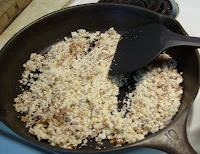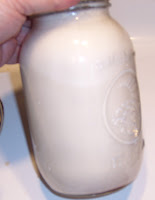 I like to know how to do things. It doesn't matter too much if I actually DO the things I know how to do, in fact, it's sort of a family joke that my sisters will say about me "Oh, she doesn't have to do that, she read a book about it." I particularly like knowing how to do things that other people don't know how to do, or don't know how to do anymore.
I like to know how to do things. It doesn't matter too much if I actually DO the things I know how to do, in fact, it's sort of a family joke that my sisters will say about me "Oh, she doesn't have to do that, she read a book about it." I particularly like knowing how to do things that other people don't know how to do, or don't know how to do anymore.I'm not sure where making my own sausage falls in that description. Around here, lots of people make deer bologna in the fall, after hunting season, so I guess making sausage doesn't really put me too far out of the norm for central Pennsylvania. Well, at least the sausage making doesn't put me there, I can't speak to the rest of what I do...
Layla and I have been having a conversation about a kind of Eastern European sausage called cevapi, and another kind Chuck and I bought last week with our lepinja. That conversation reminded me that I wanted to write about our sausage making experience.
Last May, I bought Chuck a sausage making kit from an online source as an anniversary present. (He bought me a mozzarella cheese making kit, and was quite surprised when I told him that's what he got for me!)
When the kit arrived, I got out what I thought was my grandmother's meat grinder, only to discover it was this tool. Stymied, we went to our local downtown hardware store where everything, including the kitchen sink is sold, and bought a grinder for about $30.00. It has turned out to be a VERY useful tool, by the way.
The Amish farmer from whom we get our lamb, pork and sheep milk cheese also does chickens during the summer. The year before, I had frozen a bunch of chickens at the end of the season, but was unsatisfied with that- they kept leaping out at me when I opened the freezer door- and a 5 pound frozen rock landing on your foot is not fun. It was as if they were punishing me for eating them. This year I thought to preserve them in a less lethal (to me) way.
I had in mind a sausage made with chicken, with feta cheese, spinach and Greek seasoning. I purchased sheep milk feta when I picked up the chickens.
Chuck removed the meat from the bones of 5 chickens, and we ran it through the grinder on a coarse setting. Then we ground it again on a fine setting, adding two pounds of raw washed spinach, a pound of feta, and 1 pound of bacon. In the first grinding, the mixture had seemed dry, and my Internet research had suggested adding fat was a solution. Chuck mixed in about 1 cup of Cavender's Greek seasoning with his hands, like he would a meatloaf.
Then came the interesting part. Our kit came with natural hog casings. (Yes. Cleaned hog intestines. 'Nuff said.** ) They were packed in salt to preserve them. I washed the salt off, and soaked the casings in a bowl of warm water. By the way- the flecks in this picture are from the spinach, not from anything unsavory. This picture was taken after we had already done some sausages and Chuck had put his hand in the water.
 (My mother tells me that cleaning the intestines for sausage making was her job when, as a child, she visited her grandparents farm at slaughtering time. She didn't enjoy it.)
(My mother tells me that cleaning the intestines for sausage making was her job when, as a child, she visited her grandparents farm at slaughtering time. She didn't enjoy it.)The grinder has a tube attachment. Fish an end of the casing out of the bowl, slip it on the end of the tube just like, well, you know what it's like. Look carefully at my picture, and notice how the just end of the casing is slipped on the tube, while the rest of the intestine is trailing off into the bowl.
 Now DON'T DO IT THIS WAY! Experienced sausage-stuffers are busting a gut laughing now. This was our first attempt. What you need to do is slide the entire length of casing onto the tube, so it's all bunched up. Leave about 6 inches hanging off the end, and tie a knot- otherwise you will have sausage stuffing shooting out across your room.
Now DON'T DO IT THIS WAY! Experienced sausage-stuffers are busting a gut laughing now. This was our first attempt. What you need to do is slide the entire length of casing onto the tube, so it's all bunched up. Leave about 6 inches hanging off the end, and tie a knot- otherwise you will have sausage stuffing shooting out across your room.Unless you want 1 long hank of rope sausage, it will need to be twisted off into links. According to the directions, when an appropriate length of meat is in a casing, grab it and twist to the right a couple of twists, closing off that link. When the next appropriate amount is in the casing, twist to the left. Keep alternating.
For us the sausage stuffing was a 2 person activity. Chuck cranked and pressed the meat through the grinder, I guided the sausages, and twisted them off. I was not adept at the twisting, and could not make the links uniform in size. With practice, I think I can get it. However, the alternating twist thing was a problem for me. Unless I held all previous links in my hand and twisted them together, something always untwisted. I need to work on that.

From our 5 pounds of chicken, we got 40 variable sized links, most roughly 6 inches long. In the picture you can see the dark flecks of the spinach and the white pieces of feta. Next time, I would add more feta and cut back the seasoning- the flavor was overwhelmed by it. I might just use rosemary, oregano and a little lemon.
We froze most of the links right on the cookie sheet- something else I will not do next time. I did it this way because I couldn't figure out how to cut the sausages apart to package them for freezing while they were still soft without having the stuffing come back out. This is how we freeze berries and fruit when we want individual pieces or portions. In this case, however, it was a bad idea. The damp casing froze to the sheet, and tore when I pulled up the frozen sausage. It wasn't that big of a deal, since we put the sausages on the grill frozen anyway, but if we had thawed them it would not have been pretty. Parchment paper should do the trick of keeping them from freezing to the cookie sheet. Or I guess I could have run a wash of water over the cookie sheet to thaw the part stuck to it.
All in all, they were very tasty. What we didn't eat that night we took with us on a family camping trip, and our children agreed that they were edible. We have since made Italian sausage with elk and pork, and pork beer brats. So far, the chicken spinach and feta remain my favorite.
For a HUGE list of sausage recipes, try this site. I haven't made any from the site, but plan to.
* I wonder if I could make a tofu sausage. Or a barley-buckwheat sausage. Or a tofu-barley-buckwheat sausage. Or a bean sausage...In a synthetic casing, of course.
**Actually, let me say more. I was amazed when my father said the idea of natural casings made him queasy. The synthetic casings make me feel a little off- I would much rather have the natural thing. Goodness knows there was enough salt in the package to kill any e-coli that might be lurking. I would have preferred to have had casings from my own hog, because I know they were pastured and did not come from huge hog CAFO's, but that wasn't part of the processing package. Perhaps another time. I could have gotten the stomach, though- a dish called Hogmaw, which is basically sausage and potato stuffed in a pig stomach and baked is a traditional dish here... I have neither had it nor made it, but I probably will. And then I will write about it.
































